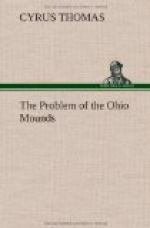Such statements as the following, attested by various contemporaneous authors, should suffice on this point:
The caciques of this country make a custom of raising near their dwellings very high hills, on which they sometimes build their houses. [Footnote: Biedma, Hist. Coll. La. vol. 2, p. 105.]
The Indians try to place their villages on elevated sites, but inasmuch as in Florida there are not many sites of this kind where they can conveniently build, they erect elevations themselves in the following manner, etc. [Footnote: Garcilasso de la Vega, Hist. Fla., ed. 1723, p. 69. ]
The chief’s house stood near the beach upon a very high mount made by hand for defense. [Footnote: Gentlemen of Elvas. Bradford Club series, vol. 5, p. 23.]
The last, which was on Tampa Bay, was most likely near Phillippi’s Point, where tradition fixes De Soto’s landing place, and where a number of mounds and shell heaps have been found. One of these, opened by Mr. S. T. Walker,[Footnote: Smithsonian Report, 1879 (1880), pp. 392-422.] was found to consist of three layers. In the lower were “no ornaments and but little pottery, but in the middle and top layers, especially the latter, nearly every cranium was encircled by strings of colored beads, brass and copper ornaments; trinkets, etc. Among other curious objects were a pair of scissors and a fragment of looking-glass.”
An earlier exploration is thus described: “The governor [De Soto] opened a large temple in the woods, in which were buried the chiefs of the country, and took from it a quantity of pearls which were spoiled by being buried in the ground.” [Footnote: Biedma. Hist. Coll. La., vol. 2, p. 101.]
Another chronicler says: “This house stood on a high mound (cerro), similar to others we have already mentioned. Round about it was a roadway sufficiently broad for six men to walk abreast.” [Footnote: Garcilasso de la Vega, Hist. Fla., ed. 1723, p. 139.] (There are good reasons for believing this to be the Etowah mound near Cartersville, Ga.) [Footnote: Thomas, Mag. Am. Hist., May, 1884, pp. 405, 406.]
The town of Talise is described as being strong in the extreme, inclosed by timber and earth. [Footnote: Garcilasso, Hist. Fla., p. 144.]
Herrera speaks of “a town of 400 houses, and a large square, where the cacique’s house stood upon a mound made by art.” [Footnote: Hist. Am., Stoven’s transl., vol. 6, p. 5.]
Father Gravier [Footnote: Shea’s Early French Voyages, pp. 126, 136.] speaks of mounds of the Akansea and “Tounika” villages.
M. La Harpe says “the cabins of the Yasous, Courois, Offogoula, and Ouspie [along the Yazoo about 1700] are dispersed over the country upon mounds of earth made with their own hands, from which it is inferred that these nations are very ancient and were formerly very numerous, although at the present time they hardly number two hundred and fifty persons.” [Footnote: Lu Rarpe, Hist. Coll. La., part 3, p. 106, New York, 1851.] (This seems to imply that there were numerous mounds unoccupied.) “In one of the Natches villages,” says Dumont, “the house of the chief was placed on a mound.” [Footnote: Mem. Hist. La., vol. 2, p. 109.]




